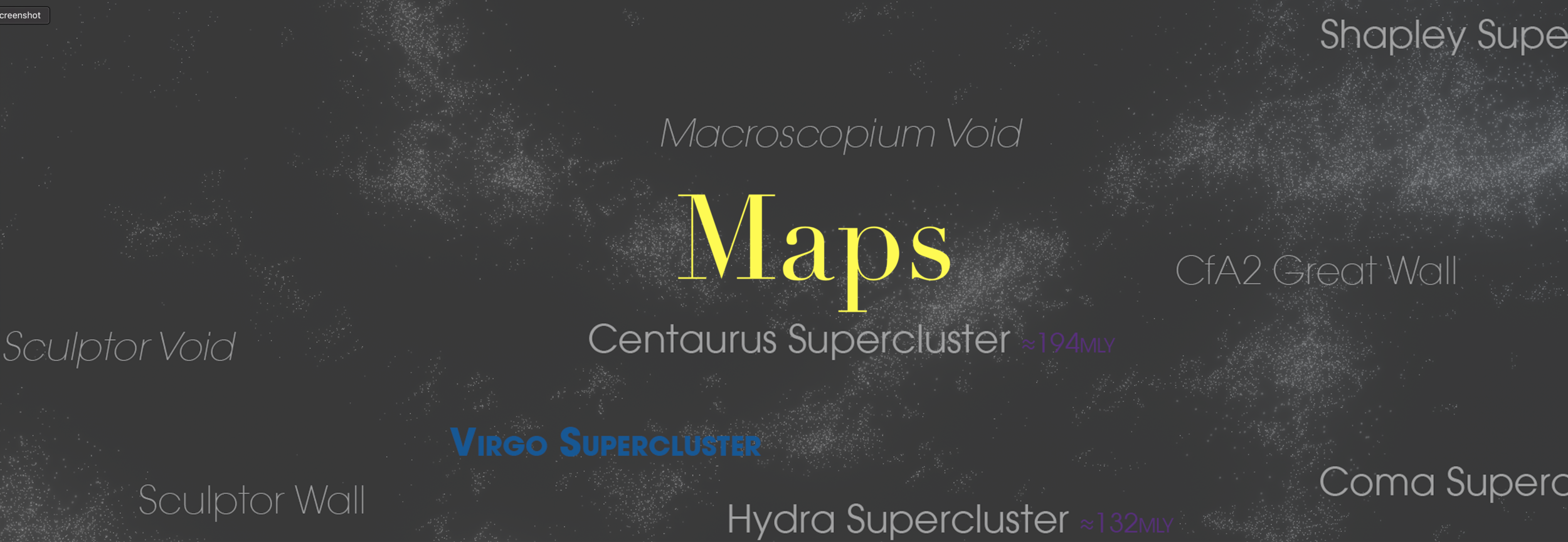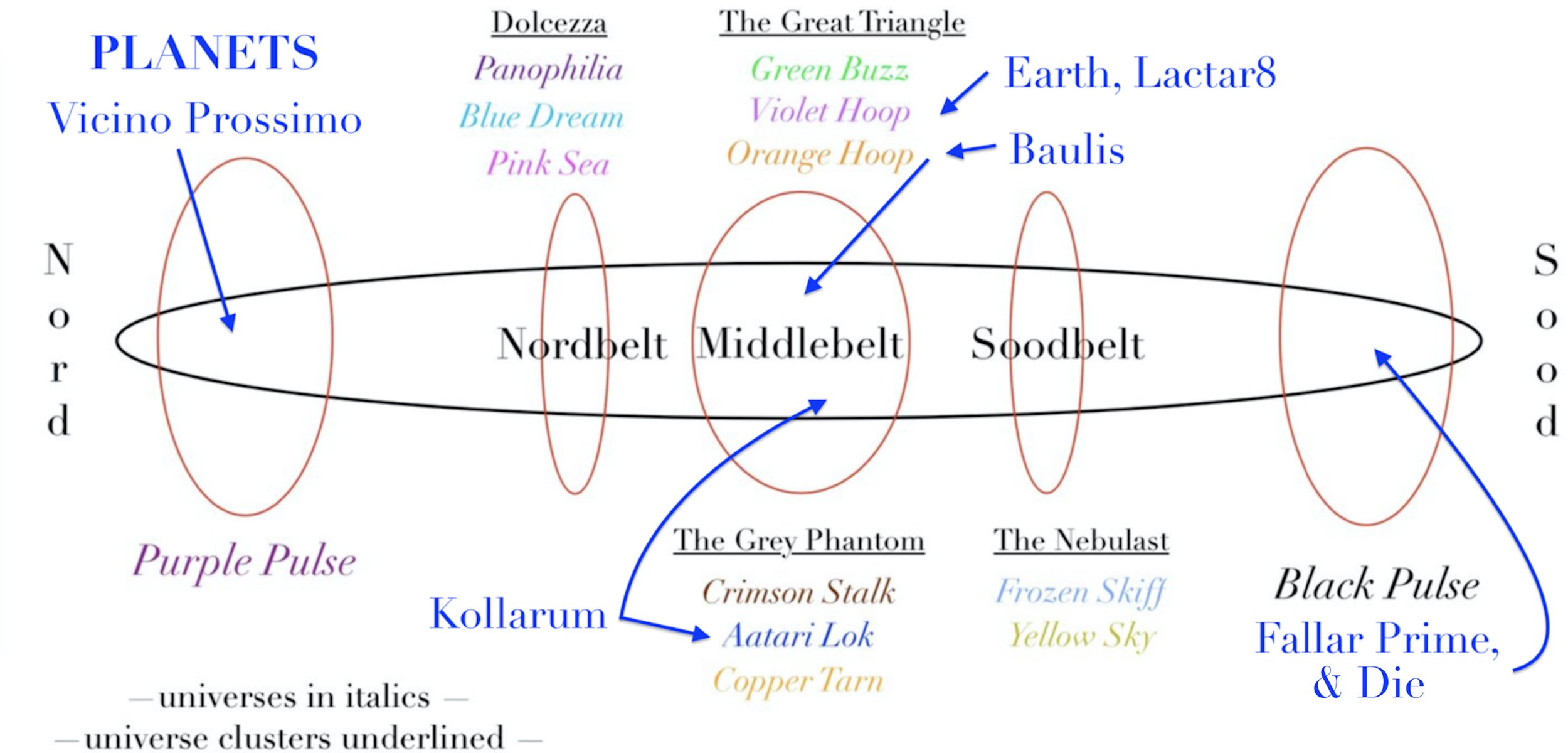Maps: Outer Space
The Kraslika — Military alliances & trade routes - The Soul Star — Planets — Die — Baulis — The Hexagon
The Kraslika
Fractal Hearts is set in the Kraslika, an oval cosmos composed of 13 universes, one of which contains our Virgo Supercluster and our Milky Way. The word kraslika comes from the Slovakian word for a coloured Easter egg.
The two most powerful universes — the Purple Pulse and the Black Pulse — lie at the opposite ends of the cosmos and are diametrically opposed in many ways. The other eleven universes are grouped into clusters or belts, all within the greater gravitational pull of the Purple Pulse and the Black Pulse.
The Purple Pulse and the Black Pulse universes are the most ancient universes and are the furthest apart. They’re also by far the largest universes — each containing about 10 trillion galaxies. As such, they determine the largest Kraslikan revolution, indicated below by the largest of the broken lines. The Purple and Black Pulse universes aren’t rotating around the universes at the centre of this diagram; instead, they’re being held in a mutual binary revolution. Nevertheless, the gravity of the Middle, Nord and Sood belts helps to keep the two Pulses in mutual revolution.
Earth and the Soul Star are located near the Local Void, which lies at the centre of the Kraslika.
The Kraslika’s history & politics is outlined in 🎲 Years.
The Milky Way is part of the Violet Hoop Universe, which is part of the Great Triangle, along with The Green Buzz and The Orange Hoop universes. The Great Triangle is held in a larger mutual rotation with the universes that constitute the Grey Phantom (The Crimson Stalk, Ataari Lok, and The Copper Tarn).
The distances involved are literally and metaphorically astronomical. While we presently understand our known universe to be about 28.5 gigaparsecs wide (93 billion light-years), in the novel our universe (The Violet Hoop) is 85 gigaparsecs wide (277 billion light-years). (A parsec equals about 3.26 light-years; a light-year equals about 9.46 trillion kilometres).
The Great Triangle is so large that instead of using gigaparsecs (billions of parsecs) it would make more sense to use ‘exaparsecs’ (quintillions of parsecs). The distance between the Purple Pulse and the Black Pulse would require the use of ‘yottaparsecs’ (septillions of parsecs). One yottaparsec would equal 10^24 parsecs, that is, 10 to the power of 24 parsecs, or 1,000,000,000,000,000,000,000,000 parsecs, or 3,260,000,000,000,000,000,000,000 light-years. Exaparsecs and yottaparsecs aren’t used in real-world astronomy because there’s nothing that large in the known universe.
🪐
Military Alliances & Trade Routes
Military alliances are explained in 🧚 The Blue Dreamers, and trade routes are explained in 💚 The English Garden.
🪐
Planets
🪐
Die & Diopolis
The planet of Die has unique characteristics which mirror (and at times anticipate) important shifts in the Kraslika. The Great Game of the Chancemasters (played in the capital city Diopolis) aims to predict these shifts and is controlled by the Demon Priests of the Black Pulse.
🪐
Baulis Prime (home planet) & Baulopolis (capital city)
The Baulians are a pink cubic species that are in the process of consolidating their Empire in the Great Triangle, which contains Lactar8, Earth, and the Soul Star.
🪐
The Hexagon
Fractal Hearts explores the infinitely small in terms of Zeno’s paradox of infinite divisibility (explored in terms of fractals), and it explores the infinitely large in terms of the Kraslika (a cosmos), the Hexagon (216 cosmoi), and the Allspace (unlimited outer space).
The Kraslika is only one cosmos among a grouping of 216 cosmoi, which are referred to as the Hexagon or the Big Six. The Hexagon is composed of 6 groups of 36 cosmoi. Each group of 36 is divided into 6 groups of six, and each of these groups of 6 is divided further into 6 separate cosmoi or “Eggs.” Our cosmos, the Kraslika, is one of these Cosmic Eggs. Because the distance between the Kraslika and the other Cosmic Eggs is so enormous, Kraslikans believe that the Kraslika comprises the totality of space.
Astronomical groupings lie at either end of 3 lines, indicated by the red, pink, and black lines above, which are similar to the X, Y and Z lines of a common graph. At the middle of each of the hexagons (where the red, pink, and black lines meet) is a nexus which serves as a meeting-place for the Looking-Glass Beings (god-like entities that travel throughout the Hexagon). For more on the origin of the Hexagon, see 🎲 The Eggs of Cosmic Chance.
Because the Hexagon originally expanded along the X, Y, and Z of conventional 3-D space, all the large astronomical groupings are arranged in the shape of an octahedron, which is an 8-sided object with 6 vertices (vertices are where two lines meet) — as in the purple octahedron inside the blue cube below:













